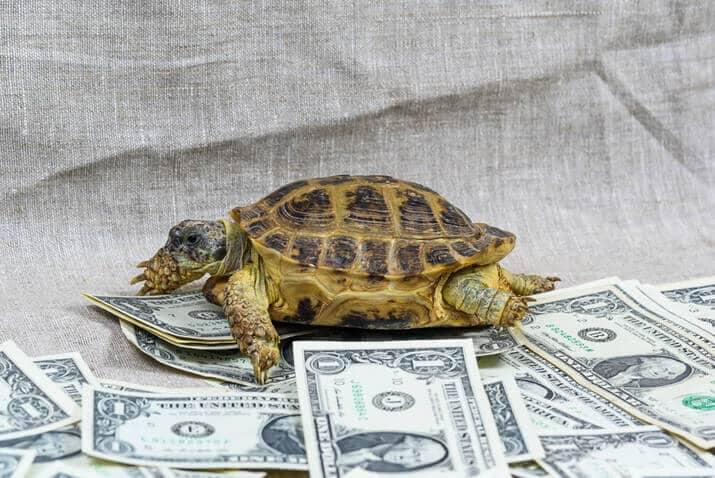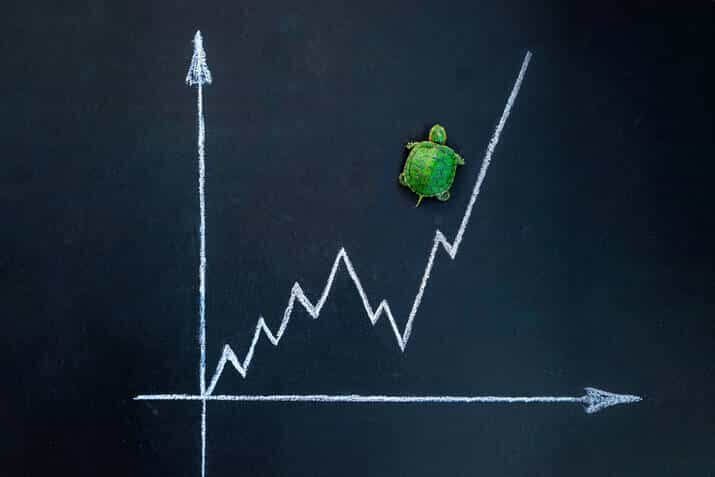
Turtle Trading System – What is it?
What are turtle traders and turtle trading systems? To answer these questions, let’s take a look at this trading experiment that marked the history of trading.
Turtle Traders: Group of Traders Come from Richard Dennis’s Turtle Trading Experiment
In the early 80′, Richard Denis, a professional trader, became particularly famous for turning an initial stake of $5000 into $100 million. His turtle trading system was a product of a discussion with his fellow trader William Exckardt. This system became one of the most famous trends following systems.
Richard Dennis considered that anyone could learn the ropes of trading on the futures market. To convince his trader friend William Eckhardt of the validity of this theory, he conducted a study in this direction.
The Turtle Trading System: How the Turtle Trading Experiment Unfolded
In 1983, Richard Dennis formed a group of 23 people (21 men and two women). They were called the group of turtle Traders, in reference to a quote from Richard Dennis, “we are going to raise traders how turtles are raised in Singapore.”
He taught them a turtle trading strategy for two weeks. Then he let them apply this trading strategy for five years. Previously he gave them each a million dollars of his personal fortune.
Richard Dennis’s teaching is based on a simple system for monitoring trends and the volatility of the markets. He taught his apprentice traders to buy or sell depending on price movements. The general trading rule states to buy when prices exceed their recent range and sell when prices fall below their recent range.
Markets traded in trend following systems experiment:
- Commodities such as coffee, cocoa, copper, sugar, silver, and cotton
- Turtle stock trading
- Bonds: 30 and 10 year US treasury bonds
- Energy: Heating oil, Cruise oil
- Currencies: The Canadian dollar, Swiss Franc, British Pound, and Japanese Jen. Besides, there were two no more existing markets: Deutschmark and French Franc.
Turtle Trading Rules
Turtle traders got the specifications on how to apply a trend-following strategy. Therefore, the goal was to follow trends, buy futures upside breakouts, and sell short at downside breakouts.
Basically, it means buying a new 20-day breakout high as an entry signal.
The exact trading idea and parameters were a secret for many years after the experiment.
Today they are even subject to copyrights. However, some general rules can be perceived clearly from his experiment.
- Watch out for prices rather than media information when making a trading decision.
- Be flexible in setting the parameters for the buy or sell signal.
- Test your parameters for various types of markets to figure out what works best.
- Plan your entry and exit points. Know when to take profits, put stop loss: Entry point: Buying once the price exceeds the 20 day high. Put a stop loss at a 10-day low.
- Calculating volatility using the average true range is advisable to vary the position size.
- Take a long position in a less volatile market. Short positions are for the most volatile markets.
- Risk management: Only put 2% of your trading account at risk
The original turtle trading rules are more complex since there is trading in both long-term and short-term breakouts.

Reading Candlesticks
Bearish Trend:
- Spot a new high of 20 candlesticks
- Make sure the close is below the previous high (false upward breakout)
- Make sure the previous high is separated from the new high by at least 3 candles (some traders require 2)
- Bearish continuation to be expected
Bullish Trend:
- Spot a new low of 20 candles
- Make sure the close is above the previous low (false downside breakout)
- Ensure that the previous low is separated from the new low by at least 3 or 2 candles.
- Bullish continuation to be expected
Turtle Trading System Results
After 5 years, the Turtle group ended up with a whopping 175 million dollars at the end of the experiment. The initial investment of $23 million has been multiplied by more than 7.
The outcome of the experiment proved that new traders could learn to trade with success. One of the members of the turtle group, Russel Sands, claims that a strategy still works.
Sands claims that with the initial investment of $10,000, you can end up with $25,000 over a year, using the turtle system.

Can the Turtle Trading System Still Work?
A combination of turtle strategy basic rules with other strategies can enhance your chances for profit no matter if you go long or short.
The core idea comes down to buying breakouts while closing trades when prices are consolidating and vice versa.
The turtle trading system experiment had a huge success. However, like any trading strategy, this one also has downsides and upsides.
The thing with the trend following systems in trading is that drawdowns could be especially deep, and most breakouts turn out to be false moves. Hence the result in a large number of losses.
Over the last two decades, the result was not even close to those from the experiment.
Considering a decreased success rate, you might wonder if the trend following system is dead. Let’s take a look at trends following core principles:
- Buy high, sell higher
- Sell low, cover lower
- Risk a portion of your capital per trade
- Trade on various markets as many as possible
- Ride the trend trailing the stop loss
Modified Rules Prove Good Results
A slight modification of turtle system rules has proven good results based on the latest data from turtle stock trading.
Comparing these general rules of trend trading and turtle system rules, you can improve the latter by exposing yourself to as many markets as possible.
For instance, you can include more commodities, currency pairs like USD/MXN, USD/ZAR, USD/INR, USD/RUB, and Indices like the S&P 500, Nasdaq, Euro Stoxx, etc.
Furthermore, you can reduce risk per trade, risking 1 percent to account instead of 2 percent.
Also, increase the breakout length and buy once the price exceeds the 200-day high instead of a 20-day breakout.
What Can Traders Learn from this Strategy
The turtle trading experiment has become one of the most famous trading stories. The turtle trading system demonstrates the importance of thoroughness in trading. However, it also requires a lot of capital at the base and is not necessarily easy when you are a novice trader.
The story of a group of rooky traders who learned to make big profits is one of the outstanding stock market legends. It’s also a great takeaway on how sticking to a specific set of criteria could help traders make more significant returns. But, the outcome is close to flipping a coin, and therefore, it’s up to you to figure out if this system is for you.
-
Support
-
Platform
-
Spread
-
Trading Instrument




